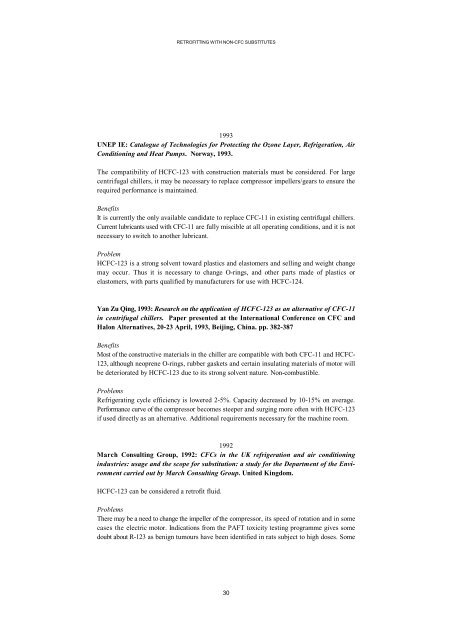retrofitting with non-cfc substitutes
retrofitting with non-cfc substitutes
retrofitting with non-cfc substitutes
Create successful ePaper yourself
Turn your PDF publications into a flip-book with our unique Google optimized e-Paper software.
RETROFITTING WITH NON-CFC SUBSTITUTES<br />
1993<br />
UNEP IE: Catalogue of Technologies for Protecting the Ozone Layer, Refrigeration, Air<br />
Conditioning and Heat Pumps. Norway, 1993.<br />
The compatibility of HCFC-123 <strong>with</strong> construction materials must be considered. For large<br />
centrifugal chillers, it may be necessary to replace compressor impellers/gears to ensure the<br />
required performance is maintained.<br />
Benefits<br />
It is currently the only available candidate to replace CFC-11 in existing centrifugal chillers.<br />
Current lubricants used <strong>with</strong> CFC-11 are fully miscible at all operating conditions, and it is not<br />
necessary to switch to another lubricant.<br />
Problem<br />
HCFC-123 is a strong solvent toward plastics and elastomers and selling and weight change<br />
may occur. Thus it is necessary to change O-rings, and other parts made of plastics or<br />
elastomers, <strong>with</strong> parts qualified by manufacturers for use <strong>with</strong> HCFC-124.<br />
Yan Zu Qing, 1993: Research on the application of HCFC-123 as an alternative of CFC-11<br />
in centrifugal chillers. Paper presented at the International Conference on CFC and<br />
Halon Alternatives, 20-23 April, 1993, Beijing, China. pp. 382-387<br />
Benefits<br />
Most of the constructive materials in the chiller are compatible <strong>with</strong> both CFC-11 and HCFC-<br />
123, although neoprene O-rings, rubber gaskets and certain insulating materials of motor will<br />
be deteriorated by HCFC-123 due to its strong solvent nature. Non-combustible.<br />
Problems<br />
Refrigerating cycle efficiency is lowered 2-5%. Capacity decreased by 10-15% on average.<br />
Performance curve of the compressor becomes steeper and surging more often <strong>with</strong> HCFC-123<br />
if used directly as an alternative. Additional requirements necessary for the machine room.<br />
1992<br />
March Consulting Group, 1992: CFCs in the UK refrigeration and air conditioning<br />
industries: usage and the scope for substitution: a study for the Department of the Environment<br />
carried out by March Consulting Group. United Kingdom.<br />
HCFC-123 can be considered a retrofit fluid.<br />
Problems<br />
There may be a need to change the impeller of the compressor, its speed of rotation and in some<br />
cases the electric motor. Indications from the PAFT toxicity testing programme gives some<br />
doubt about R-123 as benign tumours have been identified in rats subject to high doses. Some<br />
30
















